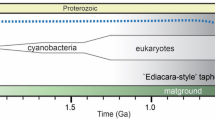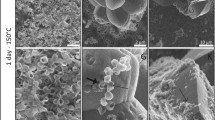Abstract
Microbial biofilms and mats are documented as fossils in rocks throughout the 3.5 b.y.-old morphological fossil record of life on Earth (Westall et al., 2000). The polymer-rich biofilms are, per se, highly robust structures capable of great resistance and durability. Moreover, the abundance of active groups in the polymers which can chelate mineral ions in solution, assures their ready preservation in the rock record. These active groups include the carboxylate, hydroxyl, amine and phosphate groups (Geesey and Jang, 1989). Precipitation of minerals within a microbial biofilm can be influenced by microbial metabolic control of the microenvironment. Furthermore, the presence of an organic template with active nucleation sites also contributes towards bio-catalysed precipitation of minerals. Some of the best-known examples of mineralised biofilms in the geological record are calcified and silicified stromatolites (Krumbein, 1983). Mineralisation of organic templates can occur very rapidly (within a day, Toporski et al., 2001a). Experiments to silicify microorganisms also document the potential faithfulness of reproduction of the original organism, and the fineness of detail obtainable, by silica impregnation (Westall et al., 1995; Westall, 1999; Toporski et al., 2001a).
Access this chapter
Tax calculation will be finalised at checkout
Purchases are for personal use only
Preview
Unable to display preview. Download preview PDF.
Similar content being viewed by others
References
Awramik, S.M., Schopf, J.W., and Walter, M.R. (1983) Filamentous fossil bacteria from the Archaean of Western Australia. Precambrian Res., 20, 357–374.
Byerly, G., Lowe, D.R., and Walsh, M.M. (1986) Stromatolites from the 3300–3500 Myr Swaziland Supergroup, Barberton Mountain Land, South Africa. Nature, 319, 489491
Byerly, G.R. and Palmer, M.R. (1991) Tourmaline mineralisation in the Barberton greenstone belt, South Africa: Early Archaean metasomatism by evaporite-derived boron. Contrib. Minerol. Petrol., 107, 387–402.
Cabrol, N.A. and Grin, E.A. (1999) Distribution, classification, and ages of martian impact crater lakes. Icarus, 142, 160–172.
Canfield, D., Habicht, K.S., and Thamdrup, B. (2000) The Archaean sulfur cycle and the early history of atmospheric oxygen. Science, 288, 658–661.
Carr, M.H. (1996) Water on Mars. Oxford, N.Y.
Carr, M.H. (1999) Retention of an atmosphere on early Mars. J. Geophys. Res., 104, 21,89721, 909.
Chyba, C.F., Thomas, P.J., Brookshaw, L., and Sagan, C. (1990) Cometary delivery of organic molecules to early Earth. Science, 249, 366–373.
Clifford, S.M. (1993) A model for the hydrologic and climatic behaviour of water on Mars. J. Geophys. Res., 98, 10,973–11, 016.
Cockell, C.S., 2000. The ultraviolet history of the terrestrial planets–implications for biological evolution. Planetary Space Sci., 48: 203–214.
Decho, A. (1994) Molecular-scale events influencing the macro-scale cohesiveness of exoplymers. In Biostabilisation of Sediments (ed. W.E. Krumbein, Patterson, D., and Stal, L.-J. ), BIS, Oldenburg, pp. 135–149.
De Ronde, C.E.J., de Wit, M.J., and Spooner, E.T.C. (1994) Early Archaean (>3.2 Ga) ironoxide-rich, hydrothermal discharge vents in the Barberton greenstone belt, South Africa. Geol. Soc. Amer. Bull., 106, 86–104.
De Ronde, C.E.J., DeR. Channer, D.M., Faure, K., Bray, C.J., and Spooner, E.T.C. (1997) Fluid chemistry of Archaean seafloor hydrothermal vents: Implications for the composition of circa 3.2 Ga seawater. Geochim. Cosmochim. Acta, 61, 4025–4042.
De Wit, M.J., Hart, R.A., Martin, A., and Abbott, P. (1982) Archaean abiogenic and probable biogenic structures associated with mineralised hydrothermal vent systems and regional metasomatism with implications for greenstone belt studies. Econ. Geol., 77, 1783–1802.
Folk, R.L. (1993) SEM imaging of bacteria and nannobacteria in carbonate sediments and rocks. J Sedimentary Petrol., 63, 990–999.
Gibson, E.K., McKay, D.S., Thomas-Keprta, K., Wentworth, S.J., Westall., F., Steele, A., Romanek, C.S., Bell, M.S., and Toporski, J.(2001) Life on Mars: evaluation of the
evidence within Martian meteorites ALH84001, Nakhla, and Shergotty. Precambrian Res. 106, 13–32.
Geesey, G.G. and Jang, L. (1989) Interactions between metal ions and capsular polymers. In Metal Ions and Bacteria (ed. T.J. Beveridge and D.J. Doyle) John Wiley, N.Y., 325358.
Golubic, S. and Schneider, J. (2001) Microbial endoliths as internal biofilms. In Fossil and Recent Biofilms (ed. W.E. Krumbein, T. Dornieden, and M. Volkmann ), Kluwer, Amsterdam, this volume.
Gorbuschina, A.A. and Krumbein, W.E. (2000) Subaerial microbial mats and their effects on soil and rock. In Microbial Sediments (ed. R.E. Riding and S.M. Awramik ), Springer, Berlin, pp. 161–170.
Grotzinger, J.P. and Kasting, J.F. (1993) New constraints on Precambrian ocean composition. J. Geology, 101, 235–243.
Hofmann, H.J., Grey, K., Hickman, A.H., Thorpe, R.I. (1999) Origin of 3.45 Ga coniform stromatolites in the Warrawoona Group, Western Australia. Geol. Soc. Amer. Bull., 111: 1256–1262.
Holland, H. D. (1984) The chemical evolution of the atmosphere and the oceans. Princeton, Princeton.
Jakosky, B.M. and Shock, E.L. (1998) The biological potential of Mars, the early Earth, and Europa. J. Geophys. Res., 103, 19, 359–19, 364.
Jakosky, B.M. and Phillips, R.J. (2001) Mars volatile and climate history: Water the observational constraints? Nature,in press.
Kasting, J.F. (1993). Earth’s early atmosphere. Science, 259: 920–926.
Kempe. S., and Degens, E.T. (1985) An early soda ocean ?. Chem. Geol., 53, 95–108.
Knauth, L.P. and Lowe, D.R. (2003) High Archaean climatic temperature inferred from
oxygen isotope geochemistry of cherts in the 3.5 Ga Swaziland Supergroup, South
Africa. GSA Bulletin,115, 566–580.
Krumbein, W.E. (1983) Stromatolites — the challenge of a term in space and time. Precambrian Res., 20, 493–531.
Krumbein, W.E. and Stahl, L.-J. (1991) The geophysiology of marine cyanobacterial mats and biofilms. Kieler Meeresforsch., 8, 158–163.
Maher, K.A. and Stevenson, D.J. (1988) Impact frustration of the origin of life. Nature, 331, 612–614.
Malin, M.C. and Edgett, K.S. (2000) Evidence for recent ground water seepage and surface runoff on Mars. Science, 288, 2330–2335.
Mojzsis, S.J., Arrhenius, G., Keegan, K.D., Harrison, T.H., Nutman, A.P. and Friend, C.L.R., 1996. Evidence for life on earth 3,800 million years ago. Nature, 384, 55–58.
Nijman, W., K.H. de Bruijne, M. Valkering, (1998) Growth fault control of Early Archaean cherts, barite mounds and chert-barite veins, North Pole Dome, Eastern Pilbara, Western Australia, Precambrian Res., 88, 25–52.
Nijman, W., Willigers, B.J.A., and Krikke, A. (1998) Tensile compressive growth structures: relationships between sedimentation, deformation, and granite intrusion in the
Archaean Coppin Gap greenstone belt, Eastern Pilbara, Western Australia. Precambrian Res., 88, 83–108.
Ohmoto, H., Kakegawa, T. and Lowe, D.R. (1993) 3.4-billion-year-old biogenic pyrites from Barberton, South Africa Science, 262, 555–558.
Pavlov, A.A., Kasting, J.F., Brown, L.L., Rages, K.A., and Freedman, R. (2000) Greenhouse warming by CH4 in the atmosphere of the early Earth. J. Geophys. Res., 105, 11,98111, 990.
Phillips, R.J., Zuber, M.T., Solomon, S.C., Golombek, M.P., Jakosky, B.M., Banerdt, W.B., Smith, D.E., Williams, R.M.E., Hynek, B.M., Aharonson, O., and Hauck, S.A. (2001) Ancient geodynamics and global-scale hydrology on Mars. Science,in press.
Rosing, M.T (1999) 13C depleted carbon microparticles in >3700-Ma seafloor sedimentary rocks from Westa Greenland. Science, 283, 674–676.
Ryder, G., Koeberl, C., and Mojzsis, S.J. (2000) Heavy bombradment of the Earth at —3.85 Ga: The search for petrographic and geochemical evidence. In Origins of the Earth and Moon
Schidlowski, M. (1988) A 3,800-million-year isotopic record of life from carbon in sedimentary rocks. Nature, 333, 313–335.
Sleep, N.H. and Zahnle, K.I (1998) Refugia from asteroid impacts on early Mars and early Earth. J. Geophys. Res., 103, 28,529–28, 544.
Sleep, N.H. and Zahnle, K. (2001) Carbon dioxide cycling and implications for climate on ancient Earth. J. Geophys. Res., 106, 1373–1399.
Toporski J.,Westall F., Steele A., Thomas-Keprta, K., and McKay D.S. (2001a). The simulated silicification of bacteria — new clues to the modes and timing of bacterial preservation and implications for the search for extraterrestrial microfossils. Astrobiology,in press.
Toporski J., Steele A., Westall F., Avci R., Martill M., and McKay D.S., (200 lb). Morphological and spectral investigation of exceptionally well preserved bacterial biofilms from the Oligocene Enspel formation, Germany. Geochim. Cosmochim. Acta,in press.
Toporski J., Steele A., McKay D.S., and Westall F. (2001c) Bacterial biofilms in Astrobiology: the importance of life detection. In Fossil and Recent Biofilms (ed. W.E. Krumbein, T. Dornieden, and M. Volkmann ), Kluwer, Amsterdam, this volume.
Walsh, M.M., 1992. Microfossils and possible microfossils from the Early Archean Onverwacht Group, Barberton Mountain Land, South Africa. Precambrian Res., 54, 271–293.
Walsh, M.M. and Lowe, D.R. (1985) Filamentous microfossils from the 3,500 Myr-old Onverwacht Group, Barberton Mountain Land, South Africa. Nature, 314: 530–532.
Walsh, M.M. and Lowe, D.R. (1998) Modes of accumulation of carbonaceous matter in the early Archaean: A petrographic and geochemical study of the carbonaceous cherts of the Swaziland Supergroup, in Geologic evolution of the Barberton Greenstone Belt, South Africa, edited by D.R. Lowe and G.R. Byerly, Geol. Soc. Am. Sp. Paper 329, pp. 115–132.
Walsh, M.M. and Westall, F. (2001) Archean biofilms preserved in the 3.2–3.6 Ga Swaziland Supergroup, South Africa. In Fossil and Recent Biofilms (ed. W.E. Krumbein, T. Dornieden, and M. Volkmann ), Kluwer, Amsterdam, this volume.
Westall, F. (1999). The nature of fossil bacteria. J. Geophys. Res., 104: 16,437–16, 451.
Westall, F. (2000). A high resolution SEM investigation for fossil life in cherts and BIFs from the >3.7 b.y.-old Isua supracrustals. Amer. Geophys. Union, San Francisco, Dec. 2000, (Abst.).
Westall, F. and Rincé, Y. (1994). Biofilms, microbial mats and microbe-particle interactions: electron microscope observations from diatomaceous sediments. Sedimentology, 41, 147–162.
Westall, F., Boni. L., and Guerzoni, M.E. (1995) The experimental silicification of microorganisms. Palaeontol., 38, 495–528.
Westall, F. and Gerneke, D. (1998) Electron microscope methods in the search for the earliest forms of life on earth (in 3.5–3.3 Ga cherts from the Barberton greenstone belt, South Africa): applications for extraterrestrial life studies. Proc. SPIE, Intl. Soc. Opt. Eng., 3114, 158–169.
Westall, F., Steele, A., Toporski, J., Walsh, M., Allen, C., Guidry, S., McKay, D., Gibson, E., and Chafetz, H. (2000). Polymeric substances and biofilms as biomarkers in terrestrial materials: Implications for extraterrestrial materials. J. Geophys. Res., 105, 24,51124, 527.
Westall, F., de Wit, M.J., Dann, J., de Ronde, C.E.J., Gaast, S.J. and Gerneke, D. (2001) Early Archaean fossil bacteria and biofilms in in hydrothermally-influenced, shallow water sediments, Barberton greenstone belt, South Africa. Precambrian Res., 106, 93–116.
Westall, F. and Folk, R.L. (2003) Exogenous carbonaceous microstructures in Early Archaean cherts and BIFs from the Isua greenstone belt: Implications for the search for life in ancient rocks. Precambrian Res.,in press.
Wilde, S.A., Valley, J.W., Peck, W.H., and Graham, C.M. (2001) Evidence from detrital zircons for the existence of continental crust and oceans on the Earth 4.4. Gyr ago. Nature, 409, 175–178.
Author information
Authors and Affiliations
Editor information
Editors and Affiliations
Rights and permissions
Copyright information
© 2003 Springer Science+Business Media Dordrecht
About this chapter
Cite this chapter
Westall, F., Walsh, M.M., Toporski, J., Steele, A. (2003). Fossil Biofilms and the Search for Life on Mars. In: Krumbein, W.E., Paterson, D.M., Zavarzin, G.A. (eds) Fossil and Recent Biofilms. Springer, Dordrecht. https://doi.org/10.1007/978-94-017-0193-8_32
Download citation
DOI: https://doi.org/10.1007/978-94-017-0193-8_32
Publisher Name: Springer, Dordrecht
Print ISBN: 978-90-481-6412-7
Online ISBN: 978-94-017-0193-8
eBook Packages: Springer Book Archive




